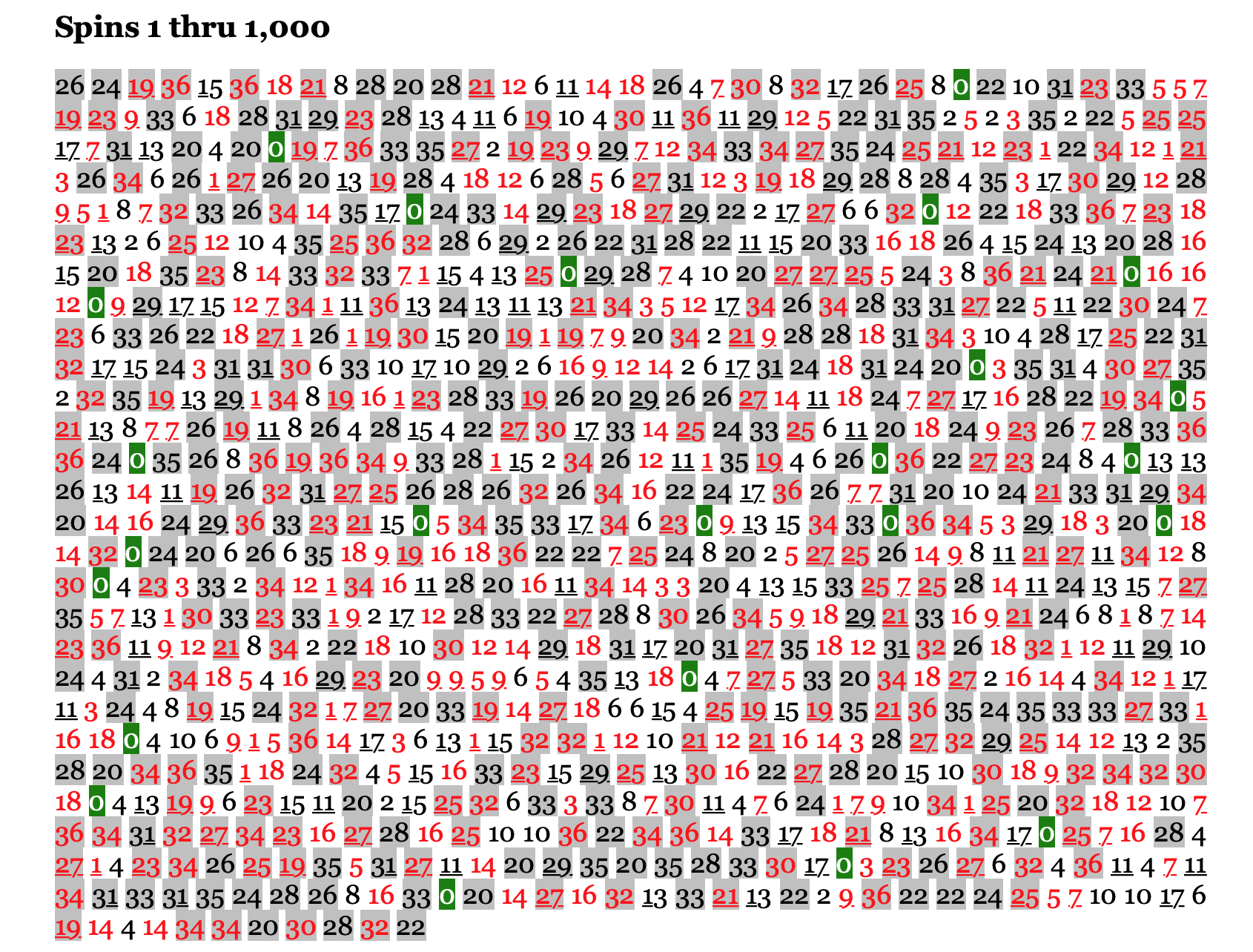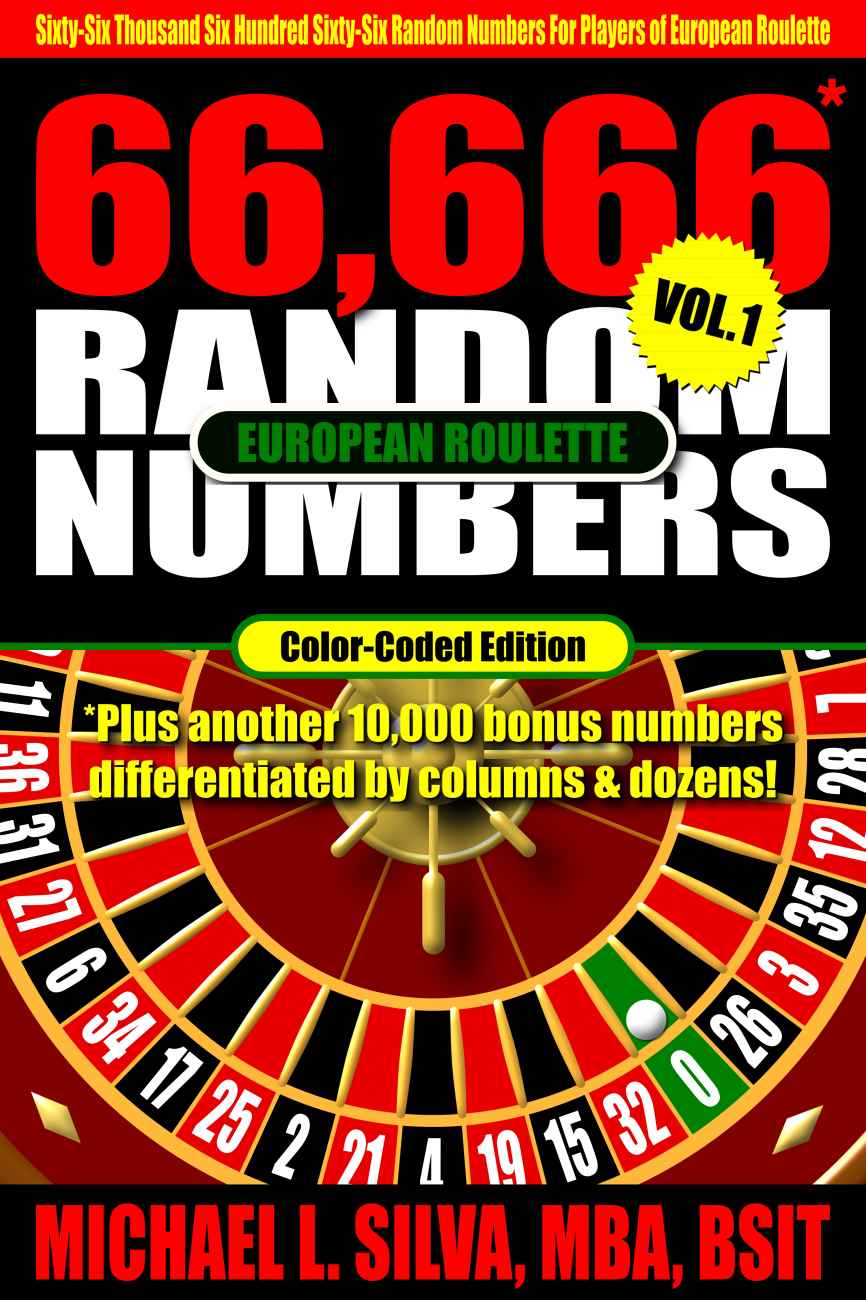A while ago I posted about gambling at roulette, and explained that whatever strategy you adopt – excluding the possibility of using electronic equipment to monitor the wheel and ball speeds, and improve prediction of where the ball will land – no strategy can overcome the edge that casinos offer by giving unfavourable odds on winning outcomes. Now, believe it or not, I do a fair bit of research to keep this blog ticking over. And in the course of doing the research for a potential casino/roulette post, I came across this book:
That’s right: 66,6666 random numbers. But not just any numbers: the numbers on a roulette wheel, 0-36. The numbers are also colour coded as per a standard roulette wheel. Here’s a typical page:

But there’s more:
- The book includes a bonus set of an extra 10,000 random numbers. (Question: why not just call the book 76,666 random numbers?)
- There’s also an American Edition, which is almost identical, but accounts for the fact that in American casinos, the wheel also includes a 00.
- This is just Volume 1. Further volumes don’t seem to have gone into production yet, but the title suggests it’s just a matter of time.
Now, tables of random numbers have their place in history. As explained in an earlier post, simulation is a widely-used technique in statistical analysis, when exact mathematical calculations for statistical problems are too complicated. And before computers were widely available, it was commonplace to use tables of random digits as the basic ingredient for simulation routines.
But, hello! This is 2019. Chances are there’s a reasonable random number generator in the calculator on your phone. Or you can go here and fiddle around with the settings in the dialog box. Or you can fire-off 66,666 random numbers with a one-line code in R or any other statistical language. You can even do it here:
[datacamp_exercise lang=”r” height=”500″ min-height=”500"]
[datacamp_pre_exercise_code]
[/datacamp_pre_exercise_code]
[datacamp_sample_code]
# simulate the results
numbers <- sample(0:36, 66666, replace=T)
# tabulate the results
table(numbers)
# show results as a barplot
library(ggplot2)
df<-data.frame(table(numbers))
colnames(df)<-c(‘number’,’frequency’)
ggplot(data=df, aes(x=number, y=frequency)) + geom_bar(stat=”identity”, width=0.5, fill=’lightblue’) +ggtitle(‘Frequencies of Results in 66,666 Roulette Spins’)
[/datacamp_sample_code]
[datacamp_solution]
[/datacamp_solution]
[datacamp_sct]
[/datacamp_sct]
[datacamp_hint]
[/datacamp_hint]
[/datacamp_exercise]
Just hit the ‘run’ button. This may not work with all browsers, but seems to work ok with Chrome.
The simulation is all done in the first non-comment line. The rest is just some baggage to tabulate the frequencies and show them graphically.
This approach has the advantages that:
- You get different numbers every time you repeat the exercise, just like in real life;
- The numbers are stored electronically, so you can analyse them easily using any statistical functions. If you ran the R session above, you’ll have seen the results in tabulated summary form, as well as in a barplot, for example. But since the data are stored in the object ‘numbers’, you can do anything you like with them. For example, typing ‘mean(numbers)’ give you the mean of the complete set of simulated spins.
So, given that there are many easy ways you can generate random numbers, why would anybody possibly want to buy a book with 66,666 random numbers? Well, here’s the author to explain:
After gaining a moderate amount of experience playing roulette, I discovered how easy it was to master the rules of the game – and still lose!
He goes on…
Having lost my bankroll and now distrusting my knowledge of statistics as they pertained to roulette, I scoured the Internet for more information on the game. My findings only confirmed what I already knew: that statistics can only define the shape and character of data and events that have already taken place and have no real bearing over the outcome of future spins.
And finally…
I chose to compile a book of 66,666 random numbers for two reasons: One, I’ve paid my dues – literally, I’ve lost thousands of dollars playing this game, and I don’t want you to suffer the same consequence; two, as roulette is a game played against the house and not against my fellow gamblers, I knew I wanted to provide you with the same opportunity to study these numbers and learn something that might just make a difference in the way you play the game.
In summary, despite having lost a fortune believing there is some system to win at roulette, and despite sincerely wishing that you avoid the same fate, having learned through experience that no roulette system can possibly work, the author has provided you with 66,666 spins (plus a bonus 10,000 extra spins) of a roulette wheel so that you can study the numbers and devise your own system.(Which is bound to fail and almost certainly cost you a fortune if you try to implement it).
Now, just to emphasise:
- The random properties of a roulette wheel are very simply understood from basic probability;
- A study of the outcome of randomly generated spins of a roulette wheel is a poor substitute for these mathematical properties;
- Biases in the manufacture or installation of a roulette wheel, which could make some numbers, or sequences of numbers, more frequent than others, are likely to be vanishingly small. But if there were such biases, you’d need to study a very long series of the outcomes of that particular wheel to be able to exploit them;
- You might choose to play roulette for fun. And you might even get lucky and win. But it is a game with negative expected winnings for the gambler, and if you play long enough you will lose with 100% certainty.
However, we’ve seen a similar mis-use of simulation before. In this post a newspaper did 100 random simulations of the NBA lottery draft in order to predict the lottery outcome. The only difference with the roulette simulation is that 66,666 is a rather bigger number – and therefore greater waste of time – than 100.
Moral: simulation can often be avoided through a proper understanding of the randomness in whatever process you are studying. But if you really have to simulate, learn the basics of a language like R; don’t waste time and money on books of random tables.

